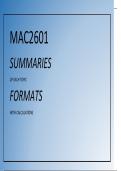Summary
MAC2601 - Full Summary with Formats
- Course
- Institution
Finding the subject daunting, struggling to get through all the study material? Need a quick recap before the test? Or just want to get ahead of the curve? This is a condensed summary with additional formats (filled with notes and formulas - to make it easier to understand).
[Show more]



